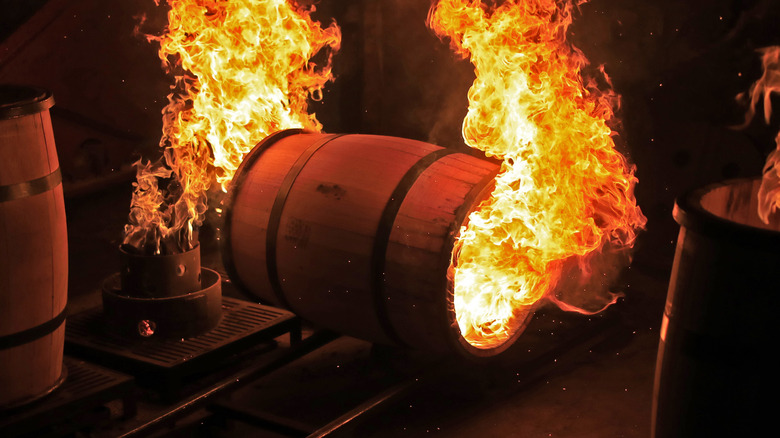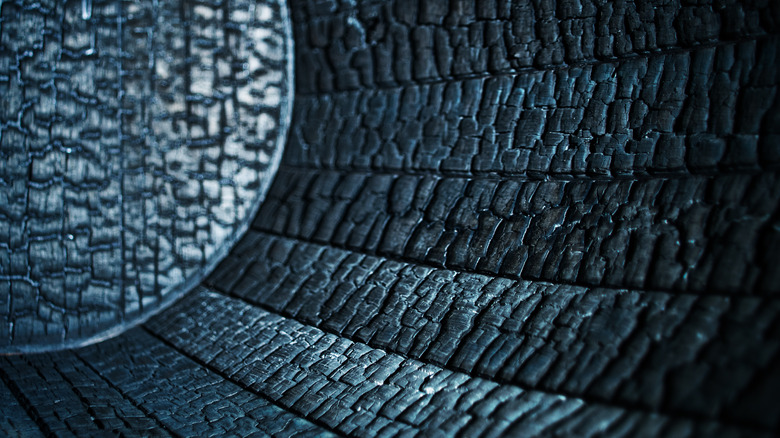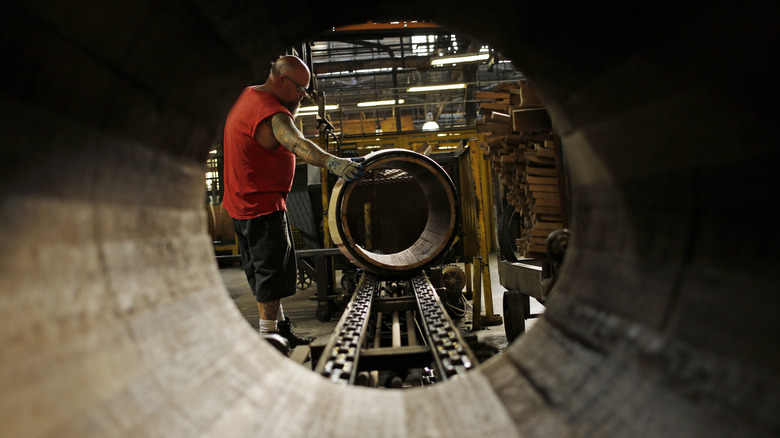Why Charred Barrels Are Essential To Bourbon Production
It is quite a spectacle to witness. Bright orange flames lick their way up the inside of the barrel before emerging like dragon's breath from the open ends. Apart from being a beautiful display of coopering theatre, charring the inside of oak barrels is an essential part of the bourbon-making process. According to Rabbit Hole Distillery, an American made whiskey cannot be called a "straight bourbon" or "straight whiskey" unless it has been aged in a newly coopered, American white oak barrel that has been charred on the inside. This is a legal regulation set down by the U.S. government.
The question is, though, what exactly led someone to light the inside of a barrel on fire in the first place? Angel's Envy explains that the practice could date as far back as the 15th century. Coopers would burn the inside of recycled barrels in order to get rid of the smell and taste of previously held goods. Heating the wood is also an integral part of the coopering process, as the heat allows the wood to be more malleable to achieve that classic barrel shape. Discovering that a spirit developed a whole new flavor profile when exposed to charred wood was likely an accident (via Difford's Guide). But it's a method bourbon makers have been incorporating for centuries to create the unique and signature flavor of their products.
How char level affects flavor
When the wood on the inside of the oak barrels begins to burn, several things happen on a microscopic level that play important roles in the whiskey aging process. The char works four compounds within the wood: lactones, tannins, lignin, and hemicellulose. Each of these compounds bring a combination of sugars, wood, toffee, and vanilla notes to the finished spirit (via Rabbit Hole Distillery). The four compounds perform different functions and are either heightened (hemicellulose) or toned down (tannins) depending on the level of charring.
According to VinePair, char levels for barrels bound for bourbon-dom are categorized using a numbered scale, with one through four being the most common. Each level coincides with the amount of time the barrels are burned for. Number One is a fifteen-second char, Two is thirty, Three is thirty-five, and Four, called the alligator char for it's scaly appearance, burns for fifty-five seconds. Most barrels are not charred for more than a minute, though some cooperages, at the request of distillers, developed a Number Seven char which burns for three and a half minutes. The greater the char, the more impact the wood will have on the bourbon's color and flavor. The higher char levels open the wood up and allow the spirit to interact with a wide surface area of both charred and uncharred parts of the barrel, leading to a more complex flavor.
Toasting vs charring
Toasting is an important part of the barrel-making process. According to Whiskey Advocate, the initial toast occurs when the coopers heat the staves of the barrel to make them more pliable to shape. This is achieved with fire that lightly toasts the face of the wood, beginning the process of turning the hemicellulose into sugars. This prime toast is short, because the barrel is not yet locked together, and heating the staves for too long will weaken the structural integrity of the finished barrel.
Though toasting is the beginning of the charring process, it does not oxidize the barrel enough for it to be considered charred. It allows the flavors and characteristics of the wood to begin opening up without causing any unwanted damage to the wood itself, per Distiller. There are levels of pre-toasting in much the same way there are levels of char. Before reaching the Number One char, two levels of Heavy Toasting occur. Heavy Toast One leaves a light brown sheen and Heavy Toast Two darkens the wood just enough to be considered a light char (per Difford's Guide). Regardless of the level at which distillers prefer their char, the fact is that toasting and charring the barrels are an essential component in the flavor definition of American whiskey.


